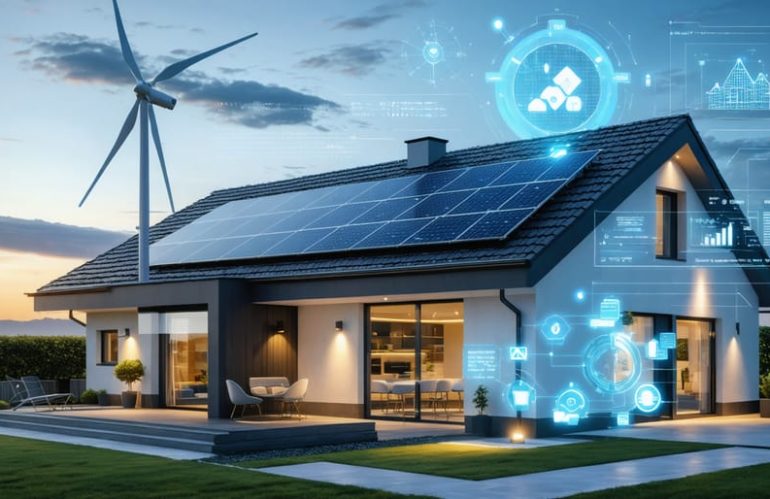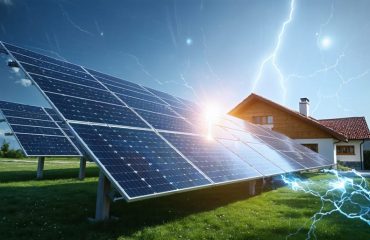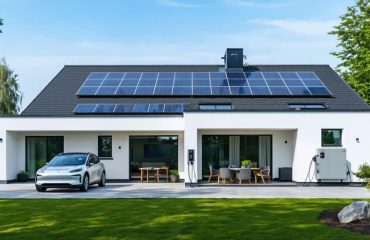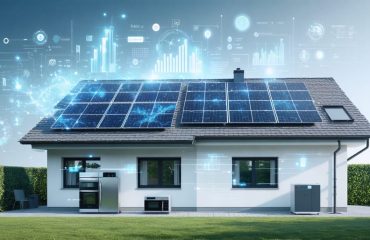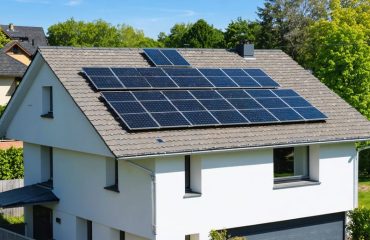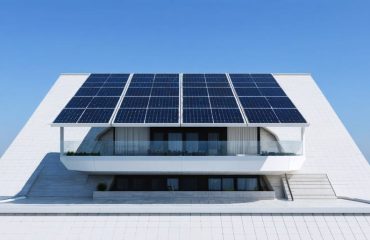Transform your home into a clean energy powerhouse by integrating residential solar panels with smart energy management systems. Modern renewable integration unlocks unprecedented control over your household energy consumption while significantly reducing utility bills. By combining solar power with battery storage, smart thermostats, and home automation systems, homeowners can now achieve up to 90% energy independence while maintaining reliable power throughout the day and night.
Gone are the days when renewable energy meant choosing between reliability and sustainability. Today’s integrated systems seamlessly blend multiple clean energy sources, automatically switching between solar, battery power, and grid electricity to optimize both performance and savings. This technological revolution puts complete energy control at your fingertips, allowing you to monitor and adjust your home’s power consumption in real-time through user-friendly smartphone apps.
Whether you’re looking to reduce your carbon footprint, protect against rising energy costs, or increase your property value, renewable energy integration offers a practical, proven solution that pays for itself through years of reliable, clean power generation.
Why Combine Solar with Other Renewable Sources?
24/7 Power Security
One of the most compelling aspects of combining different renewable energy sources is their natural ability to complement each other throughout the day and across seasons. While solar panels generate power during daylight hours, wind turbines can continue producing electricity at night or on cloudy days. By integrating these sources, homeowners can create a more reliable power supply system.
For example, solar panels typically peak in production during summer months and midday hours, while wind energy often shows stronger performance during winter months and evening hours. Adding battery storage to this mix creates an even more robust system, storing excess energy for use during low-production periods.
Many homeowners also incorporate smaller backup solutions like micro-hydro systems or biomass generators where feasible. These can provide additional power security during extended periods of low solar or wind production. Modern smart energy management systems help optimize this integration, automatically switching between sources based on availability and demand.
The result is a dependable, around-the-clock power supply that reduces reliance on the grid while maximizing the benefits of each renewable source. This integrated approach ensures that your home maintains consistent power access while minimizing environmental impact.
Maximum Energy Independence
One of the most compelling benefits of integrating renewable energy systems is achieving greater energy independence. By combining solar panels with battery storage and smart energy management systems, homeowners can significantly reduce their reliance on the traditional power grid. This self-sufficiency means you’re less vulnerable to power outages, grid failures, and rising utility costs.
Modern integrated systems can intelligently balance power generation and consumption, storing excess energy for use during peak demand periods or nighttime hours. With proper sizing and integration, many households can achieve 70-90% grid independence, dramatically lowering their monthly energy bills.
The path to maximum energy self-sufficiency often starts with solar panels but can expand to include other renewable sources like small wind turbines or geothermal systems. Smart home technology helps optimize this integration, automatically switching between power sources and storage options to maintain consistent energy supply while minimizing costs. This level of control gives homeowners unprecedented power over their energy future, providing both environmental and financial benefits for years to come.
Popular Integration Options for Your Home
Solar + Battery Storage
Solar panels paired with battery storage systems represent a powerful combination that maximizes the benefits of renewable energy for homeowners. This integration allows you to store excess solar power generated during sunny days for use when the sun isn’t shining, effectively creating your own personal power plant.
Modern battery systems, like the popular Tesla Powerwall or LG Chem RESU, can store enough energy to power an average home through the evening and overnight hours. When your solar panels produce more electricity than you need during peak sunlight hours, instead of sending that excess power back to the grid, it charges your battery system for later use.
This setup offers multiple advantages. First, it provides energy independence, reducing your reliance on the power grid and protecting you from outages. Second, it helps you maximize your solar investment by using more of the power you generate rather than selling it back to the utility company at lower rates. During peak rate periods, you can draw from your stored energy instead of paying premium prices for grid power.
Battery storage also helps smooth out the natural variations in solar power production, ensuring a consistent power supply throughout the day. Many systems come with smart features that automatically manage power flow, optimizing when to store, use, or sell your solar energy based on your consumption patterns and utility rates.
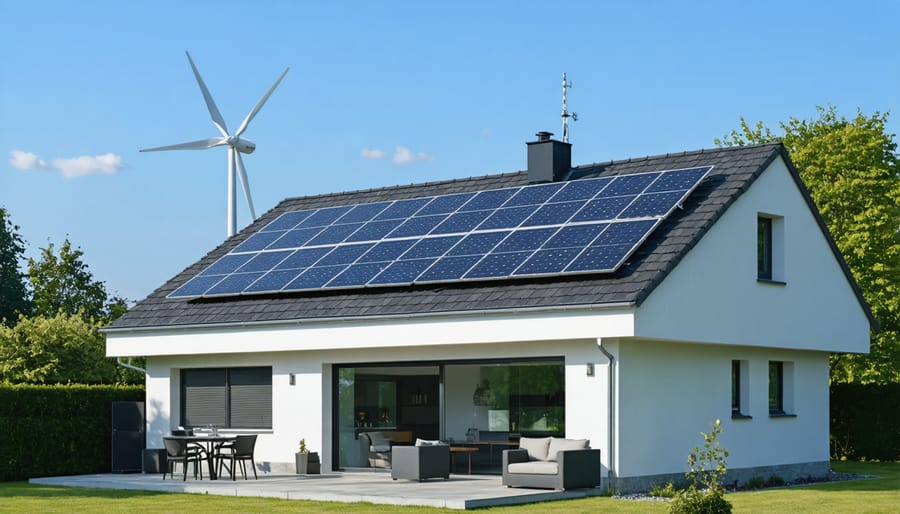
Solar + Wind Energy
Combining solar panels with wind turbines creates a powerful duo for home energy production. This hybrid approach maximizes energy generation by harnessing both sunshine during the day and wind at any time, including nights and cloudy days. When the sun isn’t shining, your wind turbine can pick up the slack, and vice versa, ensuring more consistent power generation throughout the year.
Modern residential wind turbines are surprisingly compact and quieter than ever, making them practical for many homeowners. When paired with solar panels, they typically require less roof space than a solar-only system, as the wind energy helps offset the need for additional panels. This combination can reduce your energy bills by 70-90%, depending on your location and energy needs.
The system works by connecting both power sources to a single inverter and battery storage system. During peak production times, excess energy is stored for later use, creating a reliable power supply that works in various weather conditions. While the initial investment may be higher than single-source systems, the enhanced efficiency and energy independence make hybrid systems increasingly popular among homeowners seeking sustainable solutions.
Solar + Heat Pumps
Combining solar panels with heat pump technology creates a powerful synergy for home energy efficiency. Heat pumps use electricity to move heat between outdoor and indoor spaces, providing both heating and cooling. When powered by solar panels, they become an incredibly cost-effective and environmentally friendly solution for year-round comfort.
During sunny days, your solar panels can generate the electricity needed to run your heat pump, effectively giving you free heating and cooling. This combination is particularly effective because heat pumps are already three to four times more efficient than traditional heating systems, and when powered by solar energy, their operating costs drop to nearly zero.
The partnership between these technologies also helps overcome seasonal challenges. In winter, when solar production might be lower, heat pumps remain efficient even in cold temperatures. During summer, peak solar production aligns perfectly with cooling needs, ensuring maximum benefit from your system.
For homeowners, this integration can reduce energy bills by up to 70% while significantly decreasing their carbon footprint. It’s a smart investment that provides year-round comfort while contributing to a more sustainable future.
Smart Technology Makes Integration Simple
Advanced Inverters
Modern inverters are the unsung heroes of renewable energy systems, acting as the brain that manages multiple power sources seamlessly. Unlike basic inverters that only handle solar panels, advanced inverters can coordinate power from solar panels, wind turbines, and battery storage systems all at once. This means you can maximize your renewable energy usage regardless of weather conditions or time of day.
These smart devices automatically prioritize different power sources based on availability and your home’s needs. For example, during sunny days, they’ll direct solar power to your home while charging your batteries with excess energy. When the sun sets, they’ll smoothly transition to using stored battery power, ensuring you don’t experience any interruption in service.
Advanced inverters also include features like power quality management and grid support functions. They can automatically adjust your system’s output to match your home’s exact power needs, reducing waste and improving efficiency. Many models now come with smart monitoring capabilities, allowing you to track your energy production and consumption through user-friendly mobile apps.
For homeowners considering multiple renewable energy sources, these inverters eliminate the need for separate conversion systems, saving both space and money. They’re designed to be future-proof, with the ability to integrate new energy sources or storage systems as your needs grow.
Smart Home Energy Management
Modern smart home energy management systems are revolutionizing the way we use renewable energy in our homes. These intelligent systems act like a conductor, orchestrating your home’s energy consumption to maximize efficiency and minimize waste.
Using advanced sensors and artificial intelligence, these systems can automatically adjust your home’s energy usage based on real-time factors such as weather conditions, electricity rates, and your daily routine. For example, they might run your dishwasher during peak solar production hours or store excess solar energy in batteries for later use.
The beauty of these systems lies in their simplicity for homeowners. Through user-friendly smartphone apps, you can monitor your energy consumption, set preferences, and receive notifications about optimal times to use high-energy appliances. Many systems can even learn from your habits, automatically adjusting settings to match your lifestyle while maximizing energy savings.
Integration with other smart home devices adds another layer of efficiency. Your system can communicate with smart thermostats, lighting, and appliances to create a harmonious energy-saving environment. When excess solar power is available, these systems might automatically start charging your electric vehicle or adjust your home’s temperature to store thermal energy for later use.
By optimizing your renewable energy usage, these systems typically help homeowners reduce their energy bills by 20-30% while maintaining comfort and convenience.
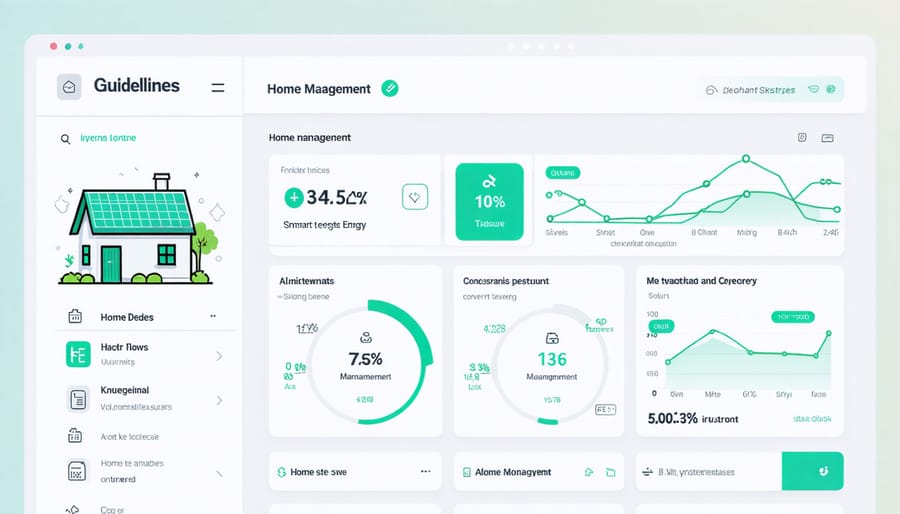
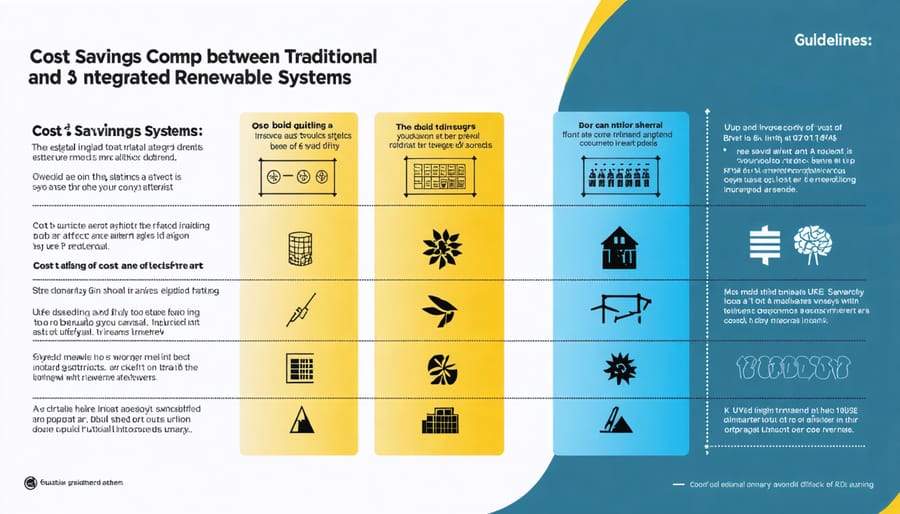
Real Cost Savings from Integration
Immediate Benefits
When you integrate renewable energy systems into your home, you’ll start experiencing benefits right away. The most noticeable immediate advantage is the reduction in your monthly utility bills. Many homeowners report savings of 50-90% on their electricity costs within the first month of installation. You can further maximize cost savings through smart energy management systems that optimize your power usage.
Federal and state tax incentives provide another immediate financial boost. The federal solar tax credit currently allows you to deduct 30% of your installation costs from your taxes. Many states offer additional incentives, including cash rebates, property tax exemptions, and performance-based incentives that pay you for the energy you produce.
Net metering programs, available in most states, allow you to earn credits for excess energy you send back to the grid. These credits appear on your very first utility bill after installation, providing instant financial returns. Some utility companies also offer special time-of-use rates for homes with renewable energy systems, helping you save even more during peak hours.
Beyond financial benefits, you’ll immediately reduce your carbon footprint and gain energy independence. Many homeowners also report increased property values from day one, with studies showing that homes with renewable energy systems sell faster and at higher prices than comparable properties without them.
Long-term Value
Investing in renewable energy integration delivers substantial long-term value that extends far beyond monthly utility savings. Homeowners who integrate renewable energy systems typically see their property values increase by 4-6% compared to similar homes without these installations. For a $300,000 home, this could mean an additional $12,000-$18,000 in value.
The financial benefits compound over time. While the initial investment might seem significant, integrated renewable energy systems often pay for themselves within 5-8 years through reduced energy bills. After this payback period, homeowners essentially enjoy free energy for the remaining lifetime of the system, which typically spans 25-30 years.
Moreover, as energy costs continue to rise, homes with integrated renewable systems become increasingly attractive to potential buyers. These properties often sell faster than conventional homes, with studies showing they spend 20% less time on the market. Insurance companies are also beginning to offer premium discounts for homes with renewable energy systems, recognizing their increased resilience and reduced risk profile.
The long-term value extends to maintenance costs as well. Modern renewable energy systems require minimal upkeep, with most manufacturers offering warranties of 20-25 years. This combination of increased property value, energy independence, and low maintenance makes renewable energy integration a sound investment for forward-thinking homeowners.
Integrating renewable energy into your home is more than just a trend – it’s a smart investment in your future and our planet’s well-being. By combining solar panels with other renewable technologies, you’re not only reducing your carbon footprint but also creating a more resilient and cost-effective energy system for your household. The benefits are clear: lower utility bills, increased energy independence, and protection against rising energy costs.
The technology has never been more accessible or affordable than it is today. With various incentives, tax credits, and financing options available, making the switch to renewable energy is within reach for most homeowners. Modern integration systems have become increasingly user-friendly, making it easier than ever to monitor and manage your home’s energy production and consumption.
As we face growing environmental challenges and energy uncertainties, taking action now ensures you’re part of the solution while securing your energy future. Whether you start with a simple solar panel installation or opt for a comprehensive renewable energy system, every step toward integration makes a difference.
Don’t wait to begin your renewable energy journey. Connect with local installers, explore available incentives, and start planning your home’s energy transformation today. The sooner you embrace renewable energy integration, the sooner you’ll enjoy its numerous benefits while contributing to a more sustainable future for generations to come.

